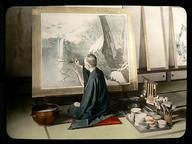Quiz Answer Key and Fun Facts
1. This term in noun form refers to a highly fanciful artform which intermingles human and animal figures with foliage, scrolls and other decorative motifs. In adjective form it has come to refer to something bizarre and absurd and has developed a negative connotation. To which 'G' word am I referring?
2. A Grisaille painting is one done entirely in shades of which color?
3. In the mid-19th century, Greek revival architecture became quite popular in the United States. Greek Revival is classified as a form of what greater movement?
4. Keith Haring and Jean-Michel Basquiat were key figures in the appropriation of what form of street art into the elite museum-art culture?
5. A French term, it refers to a sculpted effigy of the deceased which is laid upon the lid of a tomb or funerary monument. What is this term?
6. Which of these terms refers to a preparation which includes Plaster of Paris or some other white pigment which is mixed with glue and water to form the ground for a painting or canvas?
7. Of these painters, which was not considered one of the 'Giotteschi', or followers of Giotto?
8. Also called 'body color' it is a medium of paint made with opaque pigments...what is it called?
9. Often associated with many of the great cathedrals of Europe, what do we call the period of medieval art that came just prior to the Early Renaissance?
10. The 'Happenings' artists who became active in New York during the late 1950s-early 1960s were influenced by which radical Japanese movement that included the artists Murakami and Yoshihara?
Source: Author
thejazzkickazz
This quiz was reviewed by our editing team before going online.
Any errors found in FunTrivia content are routinely corrected through our feedback system.
